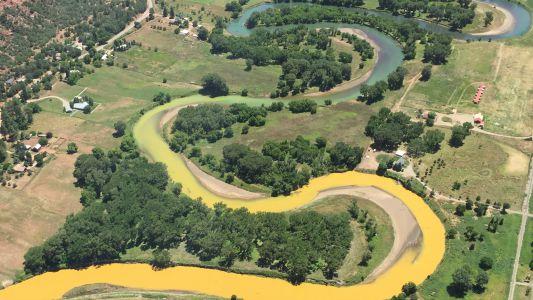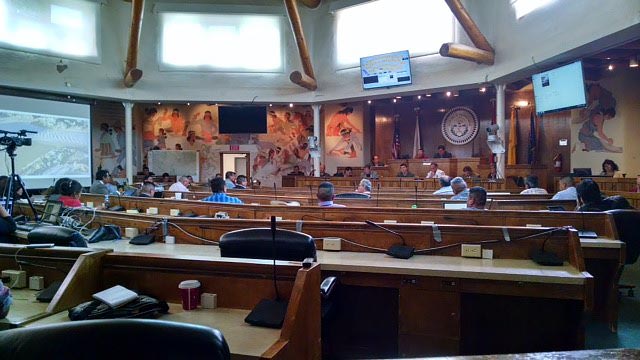
Council reacts to report on Gold King spill

Contaminated wastewater snakes its way down the Animas River on Aug. 6, 2015. (Photo courtesy KOB-TV - Channel 4 and Las Platas County Sheriff's Office.)
WINDOW ROCK

Members of the New Mexico Department of Health, San Juan Medical Center and Navajo Council gather at the Navajo Council Chambers to discuss the current status of the Animas River contamination. (Times Photo – Terry Bowman)
The toxic mine waste of heavy metals in the San Juan River, from an accident caused by the U.S. Environmental Protection Agency at the Gold King Mine in Colorado, is an assault on Navajo culture and life.
This is what Council Delegate Amber Crotty (Beclabito, Cove, Gadi’i’áhi/To’Koi, Red Valley, Tooh Haltsooi, Toadlena/Two Grey Hills, Tsé ałnáoz’t’I’í) told her colleagues and officials from the New Mexico Environment Department, New Mexico Office of the State Engineer, San Juan County in New Mexico and the chief of police for the Farmington Police Department. The leaders met Monday afternoon in the Navajo Nation Council Chamber to discuss the yellow plume of heavy metals – arsenic, lead, copper, and cadmium, among others – that are flowing in the rivers from an Aug. 5 spill that went into the Cement Creek, a tributary of Animas River, which converges with the San Juan River in New Mexico, before filtering into the Colorado River in Utah.
The plume is approximately 80 miles in length, with over 3 million tons of waste flowing in the rivers.
“This is sure an attack of who we are as Navajo people,” Crotty said in emotional testimony Monday, adding that she demands U.S. EPA release data on the heavy metals flowing in the San Juan River.
Officials of the EPA were scheduled to Skype in on the conversation with tribal, state and county officials Monday, but because they were in the remote Oljato, Utah, area, they weren’t able to connect and provide their latest updates on the spill, according to Speaker LoRenzo Bates.
Meanwhile, Crotty added that in addition to suing the EPA, efforts to sue the federal government should also happen at the United Nations level, given how this contamination affects myriad lives – humans, animals, ecosystems and cultural ecological knowledge of the Navajo people.
According to Ryan Flynn, secretary for the New Mexico Environment Department, the state has deployed its own team of scientists to investigate the toxicity of the river from the spill.
Flynn stated that he made the effort to attend the Monday meeting in Window Rock with members of the Navajo Nation Council to assure the Navajo people that the state supports and is working with the Navajo Nation to pressure the federal EPA for answers.
Flynn, who reported that he was in the field Monday conducting water tests before coming to Window Rock, said that his office has demanded EPA and the U.S. Department of Agriculture provide resources, such as potable water for the thousands of farmers and estimated 60,000 head of livestock of the region.
“If you get a water bill, then your water is safe,” he said, adding that he’s witnessing how people are fearful when he and his staff come to the floodplains to conduct tests on wells.
Flynn also reported to the council how his office is witnessing the EPA and its regions – EPA Region 8 in Colorado, EPA Region 6 in New Mexico and EPA Region 9 in Arizona and the Navajo Nation – are on different pages and sharing limited data with state and county officials from the impacted regions.
From his testing, Flynn reported positive news, noting that the wells along the floodplain show that the groundwater is feeding the wells, and not the contaminated river.
The public water system for residents of San Juan County and the City of Farmington are safe, said Kim Carpenter, county executive for San Juan County.
He said the county has water in the Farmington Reservoir that will last up to 90 days and is taking the next steps to develop a plan to get water from upstream of the San Juan River, where there is no contamination, if necessary.
Carpenter said that with the U.S. Bureau of Reclamation releasing water from the Navajo Dam, the plume – yellowish from the clay and mine waste – is dissipating and becoming clearer upstream, but it doesn’t mean that it’s safe.
The heavy metals, Carpenter said, are still a major concern, particularly for those who need water such as livestock and homeless people that rely on the river for their needs. The county has set up water stations.
“Water testing is ongoing,” he said, adding that the state and county have made it a priority to demand answers from EPA. “EPA has not responded as quickly as they should have. This impacts multiple jurisdictions,” he said.
Council Delegate Leonard Tsosie (Baca/Prewitt, Casamero Lake, Counselor, Littlewater, Ojo Encino, Pueblo Pintado, Torreon, Whitehorse Lake) said it didn’t make sense for the Navajo Nation and stakeholders from San Juan County and New Mexico to rely on data from the U.S. EPA. After all, he said, they have a conflict of interest in sampling the water sources for metals and he didn’t trust their findings because they would most likely be skewed to their ends.
Instead of relying on the federal agency, Tsosie recommended the impacted communities and multi-jurisdictional entities that govern the public in the region need to request from the feds an independent analytic team to study the contamination.
“What good is it if it’s not credible?” Tsosie said about EPA’s water sampling.
He also said that lawsuits would occur against the EPA, adding that the Navajo Nation needs to also use customary law to sue the federal agency in Navajo Nation court. And the reason, he said, is because most of the contamination is currently moving through what are considered Navajo Nation waters.
“In terms of Navajo, I think we need to know what is the worst,” Tsosie said, noting that once data becomes available on the state of the spill it needs to be shared in the Navajo language with the Navajo public.
Council delegate Davis Filfred (Mexican Water, Aneth, Teecnospos, Tółikan, Red Mesa), who represents five Navajo chapters that rely on the San Juan River for planting or drinking water in Utah, said the plume had reached Aneth Chapter Monday, according to EPA officials who kept his communities informed.
The plume and contaminants are expected to reach Lake Powell by Wednesday.
Filfred said that over 30,000 acres of crops in the Utah portion of the Navajo Nation would be impacted by the contamination. He also said that as of Tuesday the public water system from Navajo Tribal Utility Authority that provides water to locals there has two tanks running on reserves.
“Who is going to pay for bottled water?” he asked.
To read the full article, pick up your copy of the Navajo Times at your nearest newsstand Thursday mornings!
Are you a digital subscriber? Read the most recent three weeks of stories by logging in to your online account.








 Highway 264,
Highway 264, I-40, WB @ Winslow
I-40, WB @ Winslow